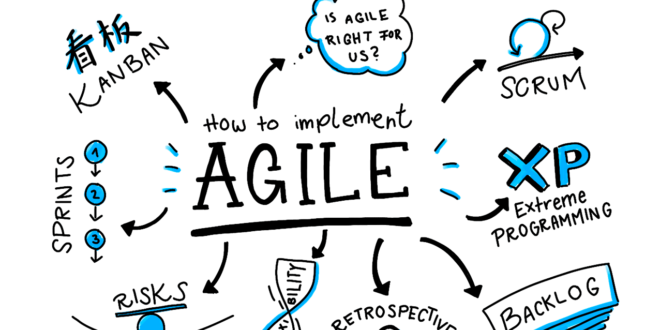You may have faced one of these issues while being a member of an organization;your products are late and do not meet expectations, the development of products are unpredictable, products are slow to launch in the market, competitors beating your products to the punch.
Agile methodology is a solution for several problems that plague development teams. The Agile methodology is a process that encourages continuous development and testing, throughout the project’s software development lifecycle. Both development and testing are done concurrently in the Agile model.
Agile methodology in consulting is the cost-effective way to seek experts’ help when using agile methodology. Agile methodology encourages leaders, teams, executives, and user groups to collaborate and work together to develop goods, software, and services on a continuous basis. Its framework adapts to changing company demands, and growth and success are measured by the creation of well-designed and functional products.
Types of Agile Methodology
- Crystal
- Extreme Programming
- Kanban
- Lean
- Scrum
- Scrumban
1. Crystal

This flexible framework focuses on people and their interactions instead of procedures and equipment. In other words, this paradigm is a natural extension of one of the Agile Manifesto’s key ideals. The Crystal technique was created for IBM in 1991 by Alistair Cockburn, who is considered as one of the initial popularizers of agile. He focused on building principles for team cooperation and communication rather than building precise step-by-step development methodologies that would work across the board for teams participating in any project. Two essential concepts underpin the Crystal agile framework:
- Teams can discern methods to enhance and optimize their workflows on their own.
- Every project is different and evolving, which is why the team in charge of that project is best prepared to define how it will approach the task.
2. Extreme Programming

The development of the Internet in the 1990s created a shift in software development. If a company’s success h on its ability to grow and bring products to market quickly, the software development life cycle has to be drastically shortened. Kent Beck created an agile project management methodology that enables frequent releases in short development cycles to enhance software quality and enables developers to adapt to changing client needs, was born in this context.
3. Kanban

It began as a scheduling system for lean production, based on the Toyota Production System (TPS). Toyota began using this manufacturing in its production in the late 1940s. The strategy is based on a pull system. This means that consumer demand rather than the traditional push model of producing items and pushing them to market drive production. Their one-of-a-kind manufacturing approach provided the groundwork for Lean manufacturing, or simply Lean. Its essential goal is to reduce waste without losing efficiency. The major objective is to provide greater value to customers while reducing expenses.
Kanban is a workflow management technique for establishing, controlling, and optimizing knowledge work services. Its goal is to assist you in visualizing your task, maximizing productivity, and continually improving. Kanban is a Japanese word that means “billboard” or “signboard.” It began in manufacturing and has since been claimed by Agile software development teams. It has just begun to be acknowledged by company units from diverse industries.
As more individuals become aware of Kanban, there are a growing number of misunderstandings. What is Kanban, exactly? What is the best way to set up a Kanban system? Here are the most crucial things to know about the approach and how to use it in practice.
4. Lean

The word “Lean” was created in the manufacturing industry to designate a production model based on the Toyota Production System (TPS) established by Sakichi Toyoda, Kiichiro Toyoda, and Taichi Ohno, who was inspired by Henry Ford. Toyota Production System transformed in the 1950s and 1970s by focusing on the notion of “total elimination of all waste.” When “The Machine That Changed the World” was released in 1990, TPS became known as “Lean Manufacturing.”
Since then, Lean has been used in management, software development, and a variety of other industries. The software development industry was reaching a crisis in the 1980s and 1990s, as projects completed using traditional waterfall, approaches were taking longer and longer. This frequently resulted in a significant gap between the identification of a business requirement and the delivery of a software solution.In particular industries with special needs, such as the aircraft sector, this lag might be measured in years or even decades. Requirements, technologies, and sometimes whole companies changed during the course of these multi-year periods. Projects would frequently be terminated midway through or completed, only to discover that what they produced no longer met the business needs outlined at the start of the project.
5. Scrum

Scrum is a methodology for addressing complex adaptive challenges while producing and delivering high-value solutions in a productive and creative manner. Scrum is an agile methodology that aids individuals, teams, and organizations in creating value by allowing them to adapt to complicated issues. The Scrum Guide was developed by Scrum founders Ken Schwaber and Jeff Sutherland to explain Scrum simply and simply. The explanation of Scrum may be found in this guide. Scrum’s accountabilities, events, artifacts, and the rules that link them together are all included in this framework. Scrum, in a nutshell, necessitates a Scrum Master to create an environment in which:
- The work for a difficult problem is ordered into a Product Backlog by a Product Owner.
- During a Sprint, the Scrum Team transforms a selection of work into a value increment.
- The Scrum Team and its stakeholders review the results and make any necessary adjustments for the next Sprint.
- Repetition
6. Scrumban

Scrumban is a project management methodology that incorporates key elements from two famous agile methodologies: Scrum and Kanban. Scrumban combines Scrum’s structure and regular procedures with Kanban’s flexibility to improve team agility, efficiency, and productivity.
Scrumban may help firms concentrate their teams on the right strategic priorities while also enhancing their procedures. Scrumban makes use of Scrum’s structure and predictability with Kanban’s flexibility and continuous workflow to create Scrumban. Scrumban, when properly applied, may allow a team to benefit from both Scrum’s prescriptive structure and Kanban’s freedom to improve their procedures.
Reasons for Using Agile Consulting Services
Agile consulting services webspaceteam.com as you may know, are regarded today as high-end professional services provided to several businesses across all industries. When company executives believe that the products and services they offer should have a strong and distinct presence in the market, they should make them available as soon as possible in order to obtain an advantage over their competitors. To get a faster time to market, such business and technology executives should adopt Agile methods of producing and sustaining their goods and services. An effective Agile practitioner would be the greatest source for them to connect with this sort of important service for transitioning their teams, programs, products, and portfolios to operate in an Agile manner.
 Comeau Computing Tech Magazine 2024
Comeau Computing Tech Magazine 2024




